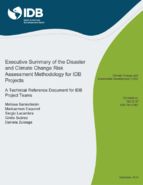Executive Summary of the Disaster and Climate Risk Assessment Methodology for IDB Projects: A Technical Reference for IDB Project Teams
Date
Dec 2018
The effects of climate change and disasters triggered by natural hazards pose a significant threat to sustainable development in the Latin America and Caribbean (LAC) region. According to the Bank’s Technical Note What is Sustainable Infrastructure, “the region is one of the most vulnerable to the impacts of a changing climate. In 2017 it experienced severe losses from natural events, including floods in Peru that cost US$3.1 billion and floods in Colombia that resulted in 329 fatalities (MunichRE NatCatService, 2017). Vergara et al. (2013) estimate that climate change will cause damages costing US$100 billion a year across the region by 2050.”
Considering climate change and disaster risks within the design and construction process is important to increase the resilience of projects. The Bank has developed a methodology to facilitate the identification and assessment of climate change and disaster risks and resilience opportunities in all relevant projects during projects’ identification, preparation and implementation phases. This provides valuable opportunity to align existing policies, procedures and methodologies in a way that creates tangible benefits for the Banks’ client countries, beneficiaries and end users as well as potential private sector investors.
Considering climate change and disaster risks within the design and construction process is important to increase the resilience of projects. The Bank has developed a methodology to facilitate the identification and assessment of climate change and disaster risks and resilience opportunities in all relevant projects during projects’ identification, preparation and implementation phases. This provides valuable opportunity to align existing policies, procedures and methodologies in a way that creates tangible benefits for the Banks’ client countries, beneficiaries and end users as well as potential private sector investors.




